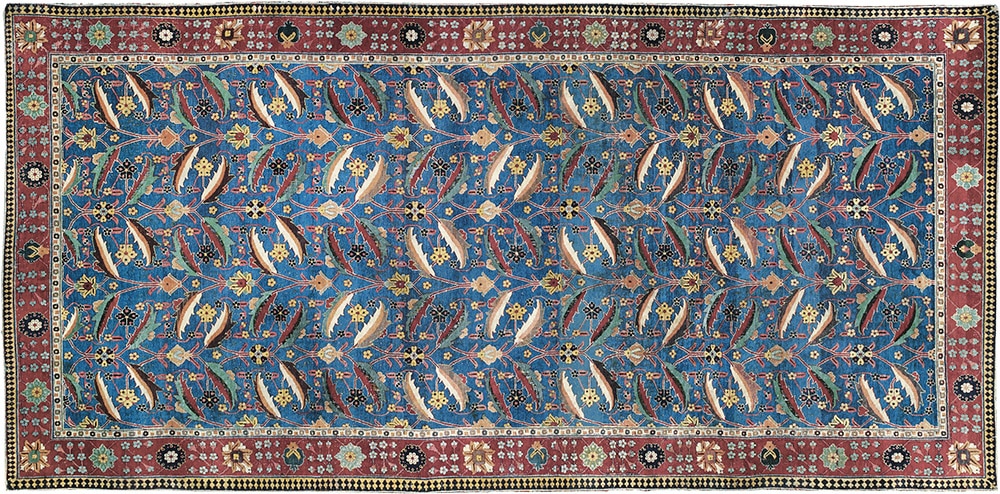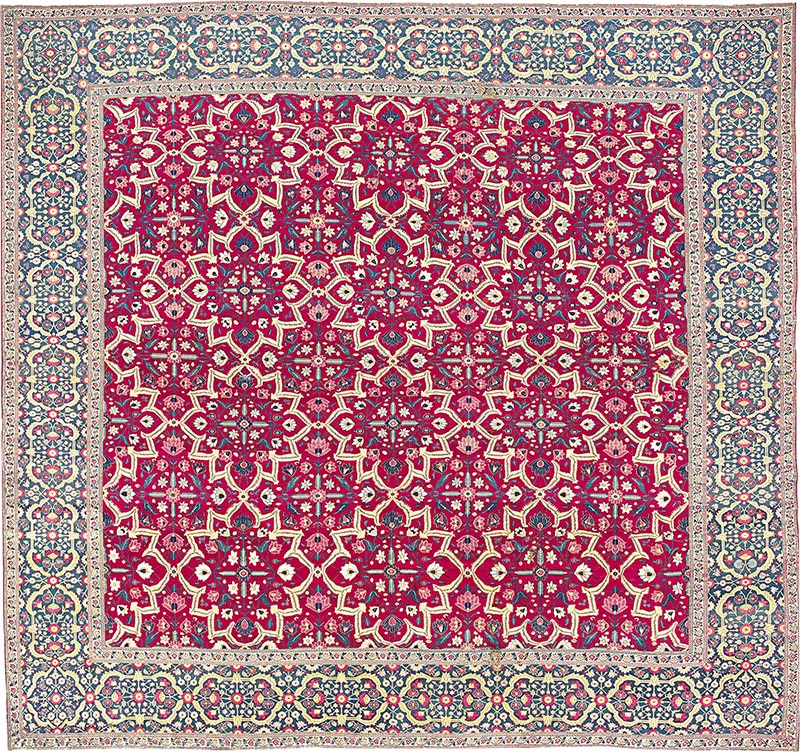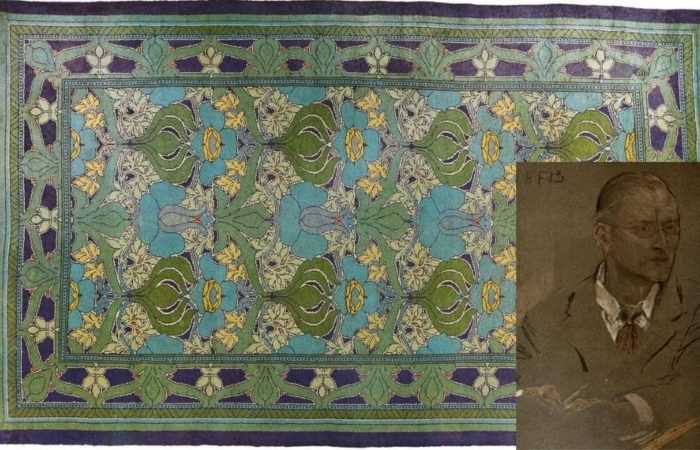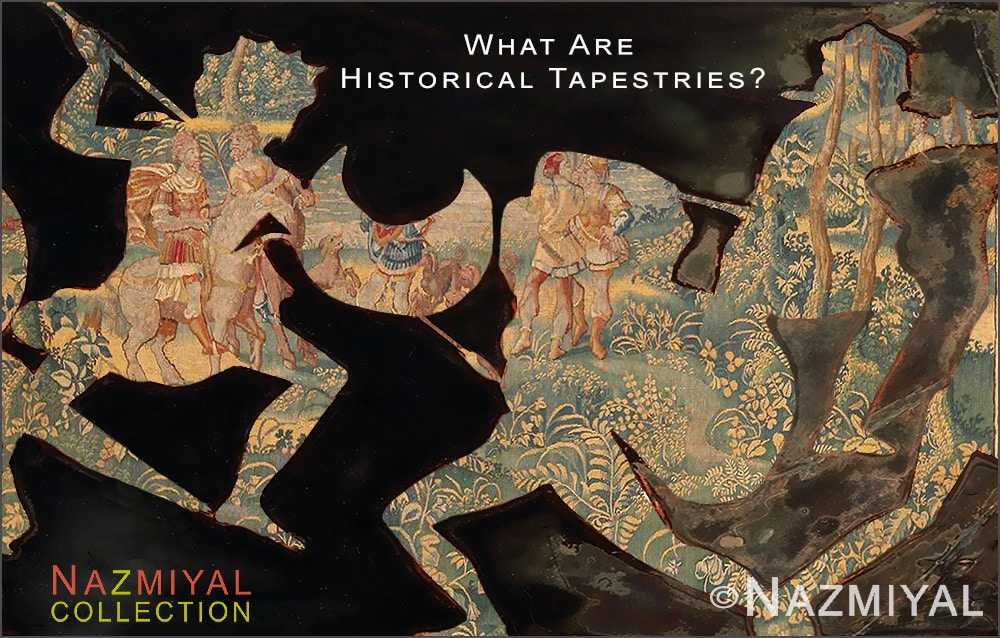Reviewing the 6 most expensive rugs every sold
Shop: Shop All Antique Rugs | Shop Rare Rugs | Shop Collectible Rugs | Shop Some The Best Rugs in The World
Learn: What are Museum Quality Rugs? | Why Are Some Rugs So Expensive? | Why Are Some Area Rugs So Cheap? | Rug Buying Guide
Below we list and explore the top 6 most expensive rugs every sold publicly – starting from the most expansive to the least expensive.
1 – The Clark Sickle-Leaf Carpet
The Clark Sickle-Leaf Carpet that sold at Sotheby’s auction on June 5 2013 for nearly $34,000,000 is one of the most famous and valuable Persian rugs in the world. It is renowned for its exceptional craftsmanship, intricate design, and historical significance.
Here’s what makes the Clark Sickle-Leaf Carpet so special:
- Rare Design: The carpet features a unique and highly detailed pattern known as the “sickle-leaf” motif. This design consists of stylized leaves arranged in a symmetrical pattern, creating a mesmerizing visual effect.
- Age and Origin: The Clark Sickle-Leaf Carpet dates back to the 17th century and is believed to have been created in the region of Persia (modern-day Iran). It is considered one of the earliest surviving Persian carpets of this caliber.
- Craftsmanship: The carpet is meticulously handwoven using the finest wool and silk materials. Its intricate design showcases the skill and expertise of the weavers who created it.
- Historical Significance: Antique carpets like the Clark Sickle-Leaf Carpet provide insights into the artistic, cultural, and societal aspects of the time period in which they were produced. They offer a glimpse into the aesthetic preferences and craftsmanship of the past.
- Rarity: Very few carpets of this quality and historical significance have survived the test of time. As a result, they are highly sought after by collectors and connoisseurs of fine art and textiles.
- Value: The Clark Sickle-Leaf Carpet gained widespread attention for its record-breaking sale price of $33.7 million in 2013, making it one of the most expensive carpets ever sold at auction. This sale highlighted its exceptional rarity and desirability.
- Cultural Heritage: The carpet represents the rich cultural heritage of Persia and its historical contributions to the art of carpet weaving. It serves as a testament to the enduring legacy of Persian craftsmanship.

Sotheby’s Clark Sickle-Leaf Carpet – The Most Expensive Rug In The Word
Overall, the Clark Sickle-Leaf Carpet stands out as a masterpiece of textile art, celebrated for its beauty, historical significance, and extraordinary value in the world of fine art and collectibles.
Learn more: Most Expensive Rug Ever Sold at Auction
2 – The Early Persian “Comtesse de Behague” Vase Carpet
The early Persian Kerman vase carpet that sold at Christie’s in London in April 2010 for nearly $10,000,000 is known as the “Comtesse de Behague” vase carpet. It is considered one of the most iconic and valuable carpets in the world, and its high price at auction reflects its exceptional rarity, historical significance, and exquisite craftsmanship.
Here’s what makes the the “Comtesse de Behague” vase carpet so special:
- Design and Motifs: The carpet features an elaborate design of large vases filled with colorful flowers, set against a dark blue background. The intricacy and vividness of the design make it a remarkable example of Persian carpet artistry. The floral motifs, executed with precision and attention to detail, are a testament to the skill of the weavers.
- Age and Origin: The Comtesse de Behague vase carpet is believed to date back to the Safavid period of the 17th century. The Safavid dynasty was known for its support of the arts and the production of high-quality rugs and textiles. The rug’s age and historical context contribute to its significance.
- Rare Size and Condition: The carpet’s size and condition further enhance its rarity. Large, well-preserved antique carpets from this period are particularly scarce. The fact that the Comtesse de Behague vase carpet has survived in such remarkable condition adds to its value.
- Provenance: Provenance, or the documented history of ownership, can significantly impact the value of an artwork or antique. The Comtesse de Behague vase carpet’s distinguished provenance, with ties to the Comtesse de Behague herself (a prominent French collector of the late 19th and early 20th centuries), adds to its allure.
- Cultural and Historical Significance: The carpet provides insights into the artistic and cultural achievements of Persia during the Safavid era. It serves as a tangible link to the past, offering a glimpse into the aesthetics and craftsmanship of the time.
- Collector Demand: The rarity and quality of the Comtesse de Behague vase carpet make it highly sought after by collectors, museums, and art enthusiasts. Its appearance at a prestigious auction house like Christie’s can lead to intense bidding competition and drive up the final sale price.

Christie’s Early Persian “Comtesse de Behague” Vase Carpet 2nd Most Expensive Rug in The World
Overall, the Comtesse de Behague vase carpet’s combination of exceptional design, historical importance, scarcity, provenance, and cultural significance contributed to its impressive sale price of nearly $10,000,000 on 15 Apr 2010. It remains a testament to the enduring value of fine art and antique textiles.
Learn more: Most Expensive Painting vs. Rug Ever Sold | Shop Vase Design Rugs | Shop 17th Century Rugs
3 – The Vanderbilt Mughal Millefleurs Star-Lattice Carpet
The Vanderbilt Mughal Millefleurs Star-Lattice carpet sold for $7,600,000 at Christies London on 8 Oct 2013. It is a renowned and valuable antique carpet that gained attention for its exceptional design, historical significance, and rarity.
Here’s what makes the Vanderbilt Mughal millefleurs star-lattice carpet special:
- Mughal Design Influence: The carpet’s design is influenced by the Mughal artistic style, which flourished in the Indian subcontinent during the 16th to 19th centuries. Mughal art is characterized by its intricate floral patterns, geometric motifs, and vibrant colors. The carpet’s design reflects the artistic sensibilities of the Mughal period.
- Millefleurs Pattern: The term “millefleurs” translates to “thousand flowers” in French. This type of design features a densely packed field of small, colorful flowers. The intricate millefleurs pattern on the carpet showcases the skilled craftsmanship and attention to detail of its creators.
- Star-Lattice Layout: The star-lattice layout refers to the repeating geometric pattern of stars that often serves as the backdrop for the floral motifs. This lattice structure adds depth and complexity to the design, creating a visually captivating effect.
- Historical Significance: The carpet is believed to have been created during the Mughal period, a time of significant cultural and artistic achievements in the Indian subcontinent. Carpets from this era offer insights into the aesthetics and cultural influences of the time, making them historically important artifacts.
- Rarity and Condition: Antique carpets in good condition from the Mughal period are relatively rare due to their age and the materials used in their creation. The fact that the Vanderbilt Mughal Millefleurs Star-Lattice carpet has survived in relatively good condition contributes to its desirability and value.
- Provenance: Provenance, or the documented history of ownership, can enhance the value of an antique. The carpet’s association with the Vanderbilt family, a prominent and wealthy American family, adds to its provenance and allure.
- Collector Demand: The combination of Mughal design elements, historical significance, rarity, and provenance makes the carpet highly sought after by collectors and connoisseurs of fine art and textiles. This collector demand can lead to competitive bidding at auction and drive up the final sale price.

Christie’s Vanderbilt Mughal Millefleurs Star-Lattice Carpet – 3rd Most Expensive Rug in The World
Overall, the Vanderbilt Mughal Millefleurs Star-Lattice carpet’s exquisite design, historical importance, rarity, condition, and notable provenance contributed to its impressive sale price of nearly $7,700,000 at Christie’s auction in October 2013. It stands as a testament to the enduring appeal of antique carpets as valuable works of art and cultural artifacts.
Learn more: Cornelius Vanderbilt Antique Mughal Rug | Shop Mughal Rugs
4 – The Pearl Carpet of Baroda
The Pearl Carpet of Baroda sold for $5,500,000 19 March 2009 at Sotheby’s auction. It is a truly exceptional and unique work of art, renowned for its exquisite craftsmanship, rich history, and lavish use of precious materials.
Here’s what makes the Pearl carpet of Baroda so special:
- Intricate Design and Craftsmanship: The Pearl Carpet of Baroda is a handwoven masterpiece adorned with intricate patterns, elaborate motifs, and meticulous detailing. It features a central medallion surrounded by a symmetrical design of flowering plants, birds, and animals. The craftsmanship involved in creating such a complex and detailed design is truly remarkable.
- Precious Materials: The rug is woven using some of the finest materials, including silk, gold, silver and a staggering number of natural pearls. These pearls are one of the defining features of the carpet and contribute to its exceptional value. The use of pearls as an ornamental element sets the Pearl Carpet of Baroda apart from other textiles.
- Historical Significance: The carpet has a storied history and is believed to have been created in Baroda (now Vadodara), India, during the late 19th century. It’s a product of the rich artistic and cultural heritage of the region, showcasing the skills of local artisans and weavers.
- Royal Provenance: The Pearl Carpet of Baroda was made for and used by the Maharaja of Baroda. Its royal provenance adds to its allure and historical importance, as it was created for a member of the Indian aristocracy.
- Rarity: The combination of intricate design, precious materials, historical significance, and royal association makes the Pearl Carpet of Baroda a rare and unique piece of art. Such textiles, especially those incorporating pearls, are not commonly found, further enhancing its value.
- Collector and Cultural Interest: Antique textiles and artifacts with royal connections and exceptional craftsmanship often attract collectors, museums, and institutions interested in preserving cultural heritage. The Pearl Carpet of Baroda’s beauty and historical context make it appealing to a wide range of enthusiasts and institutions.
- Auction Appeal: The Pearl Carpet of Baroda was sold at Sotheby’s, a prestigious auction house known for handling significant and valuable artworks. The auction setting, combined with the carpet’s rarity and historical significance, likely contributed to competitive bidding and its final sale price.

Sotheby’s Pearl Carpet of Baroda – 4th Most Expensive Rug In The World
Overall, the Pearl Carpet of Baroda’s combination of stunning design, use of precious materials, historical importance, royal provenance, rarity, and rug collector appeal led to its impressive sale price of nearly $5,500,000 19 March 2009 at Sotheby’s auction. It stands as a testament to the enduring value of fine textiles as works of art and historical artifacts.
5 – The Doris Duke Silk Isfahan carpet
The Doris Duke Silk Isfahan carpet, which sold at Christie’s on June 3, 2008, for $4,450,500.
Here’s what make the Doris Duke Silk Isfahan carpet so notable:
- Historical and Artistic Significance: Isfahan carpets are renowned for their exceptional craftsmanship and intricate designs. Isfahan, a city in Iran, has a long history of producing some of the finest Persian carpets. The Silk Isfahan carpet in question likely featured a high level of artistry, with detailed patterns and fine materials.
- Use of Silk: The use of silk in carpets is associated with luxury and a higher level of craftsmanship. Silk threads create a lustrous and detailed surface, which enhances the visual appeal of the carpet. Carpets made predominantly or entirely from silk are often highly prized for their fine texture and shimmering appearance.
- Exceptional Materials: The presence of silk in the carpet indicates a level of quality and prestige. Silk carpets require meticulous weaving and a significant amount of material, making them more rare and valuable.
- Provenance and History: The Doris Duke Silk Isfahan carpet’s provenance, or documented history of ownership, could have contributed to its value. If the carpet was previously owned by Doris Duke, who was a wealthy and prominent American heiress, philanthropist, and art collector, it would likely increase the carpet’s desirability.
- Collector Interest: Carpets with prestigious provenance, exceptional materials, and high-quality craftsmanship often attract the attention of collectors and enthusiasts. The combination of these factors can lead to competitive bidding and drive up the final sale price at auction.
- Auction Venue: Christie’s is a renowned auction house that handles valuable and prestigious artworks and collectibles. The auction setting can create a sense of excitement and competition among potential buyers, leading to higher prices.
- Market Demand: The overall market demand for rare and high-quality carpets can impact their auction prices. If there is a strong interest from collectors and investors in acquiring exceptional carpets, it can contribute to higher sale prices.

Christie’s Doris Duke Silk Isfahan carpet – 5th Most Expensive Rug In The World
In summary, the Doris Duke Silk Isfahan carpet’s combination of historical significance, use of luxurious materials, potential prestigious provenance, collector interest, and the auction environment at Christie’s all likely played a role in its impressive sale price of nearly $4,450,500 in 3 Jun 2008
Shop Antique Persian Isfahan Rugs | Shop Antique Persian Polonaise Rugs
6 – The “Magnificent Louis XV Savonnerie Carpet”
The “Magnificent Louis XV Savonnerie Carpet” woven after the design by Pierre-Josse Perrot, which sold for $4,406,000 at Christie’s in November 2000, is a prime example of the exceptional artistry, historical significance, and craftsmanship associated with Savonnerie carpets.
Here’s what makes the Pierre-Josse Perrot deign magnificent Louis XV Savonnerie carpet so special:
- Savonnerie Carpets: Savonnerie carpets are a type of French decorative carpet that originated in the Savonnerie Manufactory in France during the 17th and 18th centuries. They are known for their opulent designs, intricate patterns, and use of vibrant colors. These carpets were often made for French royalty and aristocracy, making them highly prestigious.
- Louis XV Style: The Louis XV style is characterized by its ornate and luxurious design elements. During the reign of Louis XV, art and design flourished, resulting in intricate and delicate patterns that epitomized the Rococo aesthetic. The design by Pierre-Josse Perrot reflects the elegance and refinement of this era.
- Historical and Artistic Significance: The carpet’s design after the work of Pierre-Josse Perrot, a renowned designer of the time, adds to its artistic significance. It represents a fusion of artistic vision, masterful craftsmanship, and historical context from the 18th century.
- Rarity: Authentic and well-preserved Savonnerie carpets are relatively rare, especially those that were made in the 18th century. Their limited availability contributes to their desirability and value among collectors and enthusiasts.
- Provenance and Historical Context: The history of ownership and the context in which the carpet was created can impact its value. If the carpet has a notable provenance or is linked to significant historical events or figures, it can attract greater interest from collectors.
- Auction Venue and Marketing: The sale at Christie’s, a prestigious auction house, provided a platform for collectors and enthusiasts to bid on the carpet. The auction setting can generate excitement and competition, potentially driving up the final sale price.
- Collector Demand: Collectors of fine art, antiques, and historical textiles may have a strong interest in acquiring pieces like the Louis XV Savonnerie Carpet due to their rarity, historical significance, and artistic beauty.

Christie’s Magnificent Louis XV Savonnerie Carpet – 6th Most Expensive Rug In The World
In summary, the “Magnificent Louis XV Savonnerie Carpet” woven after the design by Pierre-Josse Perrot is special due to its association with the opulent Savonnerie tradition, its exquisite Louis XV design, its historical and artistic significance, rarity, potential provenance, and the competitive auction environment at Christie’s. These factors combined to contribute to its impressive sale price of $4,406,000 sold in 2 Nov 2000.
Shop French Rugs | Shop Savonnerie Rugs

The 6 Most Expensive Rugs In The World
This rug blog about the the top 6 most expansive rugs in the world was published by Nazmiyal Rugs



